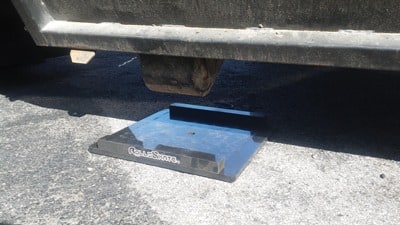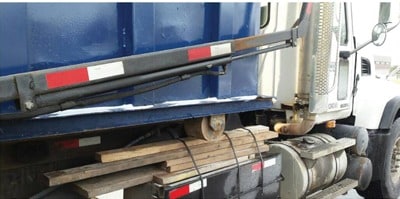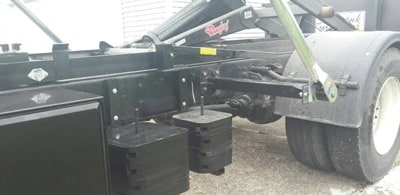Containers are a mainstay of the waste industry. Now, we need to find new ways to make transporting and delivering them more efficient.
By Jeffrey Clarke
As roll-off containers are moved from one location to another, there are always issues arise that need to be addressed. The most common practice in the waste industry currently is setting containers on wood or directly on the ground, causing container to do property damage. However, there is another solution that may be a way to mitigate these claims as well as keep operations moving forward efficiently.
Common Container Issues
When containers are set down, they are usually put on wood slats (2 x 4 or 2 x 6 lumber) or directly on the ground. A common problem with doing this is that while many drivers and companies use wood, it doesn’t stack well and strapping them to the truck is not D.O.T. approved. This creates a problem if the wood needs to be removed; it is combersome. Also because if one bungee cord breaks (or if they are using non-rated strap or haphaazard stowing of underlayment), it will be a nightmare heading down the road at 55 miles per hour.
In addition, when a container is deployed onsite or is in the process of being recovered to take offsite, a container may fall off the wood slats and end up with indentations or scuffing on its surface when hits the ground. These issues are generally caused when you cannot get the proper layout dimension of wood. This leads to property damage claims at the location where it has been used.
Container Positioning and Flotation Devices
As the roll-of container driver goes to a site, and you start to deploy the container towards the ground, a container positioning and flotation device is an efficient and effective solution to avoid these issues. First placement is under the rear wheels, while the container is continuing to deploy and it hits the shims. The truck can either be driven out from underneath the container while the container stays in the same spot or the container can be nudged, making it slide it in deeper into a property. When it is almost at the position you want it to be, another two positioning device would be placed at the front end of the container to allow for additional flotation. Then, you would fully set the container down on top of the positioning devices and disconnect and it would disperse all of the weight that you would put into that container, securing all four sides.
Although they are used in commercial, industrial and residential applications, since liability is greatest in residential, the positioning and flotation devices are specifically designed to mitigate any claims that would come up eventually as far as damage to the asphalt and any substrate you put them on. Additionally, because homeowners are present, they will see the possible damage that has been done to the property daily.
A Best Solution for Containers
Container positioning and flotation devices are to be considered as the best solution in an industry that depends on cost-effectiveness, efficiency and saving time. With multiple sizes and three different duty thickness, all having 1-inch shims, which keep the contianer centered, the holder allows them to nest upon one another—a space savings. Along with the D.O.T. compliant RolliBracket with regards to stowing on the trucks, they also allow you to deploy, position and recover the container faster without property damage and eliminate or mitigate roll-off container problems, resulting in the ability to service more jobs more jobs per day by implementing this device into your operation. Since all of the weight is positioned within the four positioning devices, the container has less of a chance to fall off and hurt the substrate, whether its asphalt or concrete (which aid in flotation and P.S.I reductions).
In addition, they require no maintenance, they are easy to install and are universal. It is rigid mounted with an L-bracket that goes on the frame of the truck. Stacking cleanily, the system can hold up to 300 lbs. and it’s lockable, so it would never half-hazardly fall off the truck.
Containers are a mainstay of the waste industry. Now, we need to find new ways to make transporting and delivering them more efficient. With container positioning and flotation devices, there is a better solution to some of the issues facing placement. | WA
Jeffery Clarke is V.P. of Sales for Rolliskate (Rochester, NY). He can be reached at (585) 730-8084, via e-mail at [email protected] or visit www.RolliSkate.com.



